PrairieTide
Tuesday, September 28, 2004
Art Marks the Spot
This weekend when I attended the Peoria Art Guild's Fine Art Fair, I actually bought something. In the past, I've wandered between the booths, overwhelmed by all the colors and choices--and the prices. This year, Randy and I are new homeowners with blank walls to fill. We went to the fair with a mission and a budget. There amid the wind-powered sculpture, the handpainted silk scarves, and pinhole camera photographs, we found a local artist who's watercolors we liked. Maybe it's the picture of the old farmhouse or the 1960's cars parked up the dirt drive, but his work seemed very midwestern. We loved the colors, we loved the composition, and best of all, no sticker shock. Attending the fair with a goal in mind may become an annual ritual here at PrairieTide.
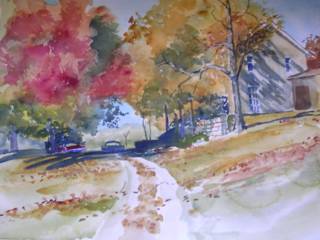
Fall is in the air.

With a little art to inspire me, I've made it up to the yoke of the Lopi Sweater. I'm not using the Lopi yarn called for in the pattern, so on Friday I stopped by my local yarn store to pick up some substitute yarn for the two-stranded colorwork that will circle the yoke. I'm going to need to play a little to see how these alternate color choices work.
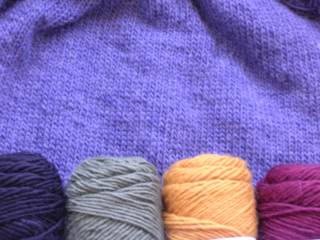
Contrasting colors for the sweater yoke.

Stopping by Mary's Yarn Store was a delight. We finally have a real yarn store in Central Illinois! Mary does not have a web site (yet), but I am very impressed with her yarn selection. When she opened about six months ago, she stocked mostly Reynold's yarn. Given the limited yarn selection in our area, this seemed a huge step forward. Now I discover she's got an impressive collection of Noro yarn, some beautiful Cherry Hill hand-dyed yarn, and an entire wall full of sock yarn. Heaven!
Mary's Yarn Store is located kitty corner from the courthouse in Eureka, Illinois, in a storefront shop. It looks like she's a part of the revival of the old Main Street in town. A coffee shop is opening up next door, and a giftstore seems to be doing brisk business across the street. The town is the home of Eureka College, the small liberal arts school that Ronald Reagan attended back in 1932, and without a doubt The Gipper is the town's Favorite Son. I may not make it to Eureka's Reagan Museum, the Reagan Peace Garden, or the Reagan Physical Fitness Center anytime soon, but I'm going to make every excuse I can to swing by Mary's Yarn Store.
Sunday, September 26, 2004
The Original Sin City
Peoria was a good-times town. Before Prohibition, Peoria was the whiskey-making capital of the world. Blessed with an ample corn supply and river transportation up to Chicago or down the Mississippi, Peoria was ideally situated to brew sourmash. The Painted Ladies, a neighborhood full of grand Victorian homes along High Street in Peoria, were once the homes of the Whiskey Barons, those feisty distillery owners that put Peoria on the map.
During Prohibition, things turned more seamy. Legal distilleries went belly up, and bootlegging booze from Florida or Canada became big business. In Peoria, the bars operated openly, and gambling and prostitution establishments had no reason to hide their businesses. Mayor Woodruff, a tolerant mayor if there ever was one, said "Peoria likes its vice," and City Hall profited from the "fines" levied on the illicit businesses run all over town.
To find out more about Peoria's speakeasy days, Randy and I attended a lecture by Taylor Pensoneau, the author of The Brothers Notorious: The Story Behind Southern Illinois' Legendary Gangsters. The Shelton Brothers were the best known gangsters in Illinois outside of Al Capone in Chicago. They ran gambling parlors, bootlegging operations, and labor racketeering all across Southern Illinois. Any illicit activity in this part of the state, they had a hand in it. Their exploits included gang wars with the Klu Klux Klan, and they resorted to using a makeshift tank to patrol their territory. In one colorful tale, they actually dropped homemade bombs on a rival gang lord's farm house.
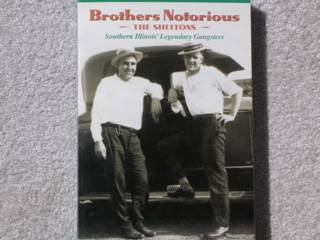
A couple of handsome gents

In 1941, after Prohibition ended, gambling operators in Peoria invited the Shelton Brothers to town to offer protection from Chicago gangsters. Soon the Shelton Brothers were running everything in Peoria. They owned fine homes on Knoxville Avenue, and horse ranches out on the country. Until two of the Shelton Brothers were assassinated by rival Chicago gangsters, the saying was in Peoria you couldn't "spit on the sidewalk with out the Shelton's permission."
Fascinating stuff. One of Peoria's high schools is named after the Mayor Woodruff, the elected official who welcomed the gangsters into Peoria's front door. According to Pensoneau, the assassination of the Shelton Brothers was front-page news across the country. The timing of the assassinations, along with general disgust with the open operation of crime gangs in the state, may have spurred the election of Adlai Stevenson, the Illinois governor who cracked down on organized crime and later ran for president.
Peoria is building a new history museum on the city's riverfront as a part of downtown rejuvenation efforts. I'm sure there will be plenty of space in the museum dedicated to Caterpillar, the largest employer in town. And there will be the obligatory quilt display, I'm sure. Let's hope that Peoria's checkered past is not glossed over. Local museums want to point out what's best about an area's past, but Peoria's gangster days would certainly add some color to what could be a very bland museum. Instead of a sentimental look at the good ol' days, knowing that the city has overcome some serious flaws merits a museum in itself.
So what does this have to do with knitting? Hey, I knit my way through the lecture, and I'm going to try my hand at knitting and reading the book this afternoon. The story about Roaring Peoria should be a page-turner.
Saturday, September 25, 2004
Last night, we met another couple at a Peoria favorite, the Ice Cream Shack, for dinner and desert. While we slurped down the last of the summer ice cream cones, the couple's toddler ran circles around our table. Demonstrating real athletic prowless, he jumped from planter, to park bench, to table top, to park bench, to planter. Round and round and round.
The whole time, his parents cooed and cheered him on, "Let's work off some of that sugar!" Me, I kept waiting for the kid to miss a landing and do a face-plant on the sidewalk. With each jump, I foresaw blood, screams, and a trip to the emergency room. But the little tyke never missed a step, and he finished his ice cream cone all by himself.
Meanwhile, my sister Sarah is expecting a baby of her own. Along pickles and cantaloup, every Mom-To-Be gets cravings to complete craft projects during the nine months of pregnancy. Our sister Wendy took up sewing when she was pregnant, and Mary just completed a patchwork quilt for her little one. Sarah's done some knitting, and she wanted a little help to get started knitting a baby blanket. So I'm sending her this care package:

Everything needed to knit a baby blanket.

Besides a stash of machine-washable baby yarn and needles, Sarah's getting a simple pattern from the Lion Yarn site, a swatch to show her the stitches, a basic knitting book, and a few rows of the blanket already started to give Sarah a head start.
To all you expectent mothers, here's a fun article to get you looking forward to having a toddler of your own some day. The fall edition of Brain, Child is out, and besides their usual spread of fine articles, they have a list of Recommended Readings for the Toddler Years. Titles include What Color is Your Pacifier? and The Purpose-Driven Tantrum. Just a little something to look forward to.
Tuesday, September 21, 2004
Meg, Jo, Beth, Amy
After reading Little Women as a kid, I wanted so much to be like Jo March, I began climbing up the willow tree that grew in front of our house with a book to read. It seemed a very Jo March thing to do--either that or dashing to the attic to write another poem. We didn't have an attic in Modesto, California, so the willow tree had to suffice. Jo always had an apple in her pocket, and she'd munch on it as she read. Of course I brought an apple along with me up the truck of the tree, even if I wasn't much of fan of apples.
It turns out that reading a book while precariously perched along a skinny willow branch is not all that comfortable. I usually couldn't read more than a few pages before my legs went numb. And the blasted apple I'd dragged up the tree with me, it would inevitably slip and fall onto the driveway below.
Reading from a tree may not have been as romantic as it sounded in the book, but I did manage one adventure while in my hidden perch. Once two neighbor ladies walked under my tree, gossiping about how crazy our family was. One said, "Can you believe they actually have seven children. SEVEN!!?" The other rolled her eyes in agreement. I nearly threw my book at them, the nerve! Instead, they never knew I was listening--because I couldn't come up with a comeback line before they walked away. I rehearsed witty replies for weeks afterwards.
Anne from Creating Text(iles) has mentioned feeling like one of the March sisters while knitting, and I can relate. In fact, watching the 1994 movie version of the book with Wynona Ryder and Kirsten Dunst is PrairieTide holiday tradition. My sisters and I consider this our "Theme Movie," and we've all picked out which role we'd play in the story. Give that I'm the oldest sister, that probably makes me bossy, proper Meg instead of fun-loving Jo.
As an undergraduate, one of my favorite classes was on 19th century sentimental literature. This was a class where we read lots of Louisa May Alcott, Harriet Beecher Stowe, and Willa Cather. The point of the class was that books written by women for the primarily a female audience have been undervalued over the years because they are considered too weepy or too sugar-sweet. Instead, we spent the class examining the strengths of the books--the portrayal of a domestic world that is easy to dismiss because it is familiar. To see the value in sentimental literature from this era, you have to value of the female experience.
So, in tribute to the March sisters and the domestic realm, I present "everyday use" knitting. Behold, a sock:
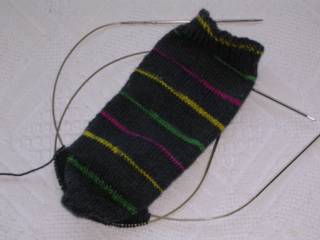
One sock, two socks. Red socks, blue socks.

I'm knitting the sock without much of a pattern, just trying it on as we go and using my general sock knitting know-how. The yarn in Reynold's Swizzle. While I like the stripes, the yarn is giving me fits. (It seems everything I'm knitting is getting on my nerves of late.) When the yarn slips off the tips of a needle, it becomes very temperamental and pouty--stubbornly resisting the need to return to the needle. I'll have to continue the search for the perfect sock yarn. In the mean time, I've turned the heal and am making steady progress towards the toe. Marmie would be proud.
Monday, September 20, 2004
The Knitting Basket
Learning about 2-color knitting has been my goal this year. I've worked up a few small projects to get the feel of it. My biggest problem with this kind of knitting is my gauge. For some reason, my stitches get way too loose when I have two yarns in my hands. Earlier this spring, I knit a couple of hats I intended to be child-sized, and both mushroomed into football helmets. Hmmm... Something to work on.
The point with these exercises was to get good enough at two-color knitting to tackle this:
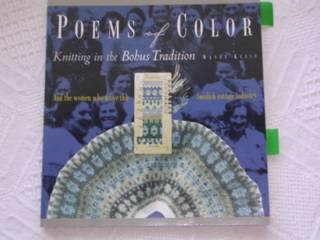
Poems of Color: Knitting in the Bohus Tradition by Wendy Keele

A year ago, I bought the kit to "The Blue Shimmer," the cardigan from the cover of the book. I bought the kit while at Stitches Midwest, a knitting feeding frenzy, and even now I'm not sure what came over me. Once it's finished, it should be an adorable 1950's angora sweater, a sweater than just begs for a poodle skirt and Oxford shoes. In the mean time, the angora yarn is difficult to work with, the needles are tiny, mistakes are impossible to fix, and the color knitting charts leave me woozy. More than once during the past year, I've taken out the kit, stitched up a lopsided swatch, and put the whole thing away in a fit of panic.
So, to build up my two-color knitting skills, I thought I should try my hand at something easier.
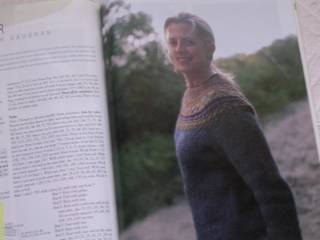
Lopi Sweater by Nora Gaughan from the Fall 2003 edition of Interweave Knits

The Lopi Sweater sweater makes use of the same traditional Bohus-style two-color knitting as Blue Shimmer. For those of you who don't have a stack of knitting books on your night stand, Bohus is a region in Sweden with a lively knitting tradition. Most two-color knitting uses only knit stitches. The Bohus style of two-color knitting makes use of the occasional purl stitch to add texture and a dash of unexpected color. What makes this sweater a good learning project is the fact that it's knit with much thicker yarn, so it will be a lot less stitches to contend with. It's also a pullover instead of a cardigan, and the design uses five contrasting colors instead of eight similar shades of blue.
Here's what I've got so far. Hopefully I can get to the fun color part by the end of the week.

Inchworm Progress

Instead of using the Lopi yarn called for in the pattern, I picked up Lamb's Pride Worsted from my local yarn store. I've never used Lamb's Pride, but it's known to be a good basic. Reasonably priced, nothing fancy, good for beginning knitters. After this test drive, I think I'll refrain from ever using it again. I've tried plastic, metal, and bamboo needles, and the yarn still fights me. It's easy to split stitches, it snags on everything, and for no reason the stuff just pops off my needles. And I'm not even to the two-color section yet, which promises to be a real party. To make matters worse, the yarn is the scratchy kind that gives wool a bad reputation. Wearing the sweater, it will probably be so warm it will feel nuclear powered.
So what am I going to do with this "learning opportunity" once I've finished? Give it as a gift, of course! Some poor, unsuspecting family member will probably find this wooly mammoth of a sweater tucked under the tree. Heh, heh, heh. Laurie the Knitting Christmas Elf from Hell. To the future recipient: all I ask is that you take one photo wearing the sweater. Smile in the picture, wave, look happy to have a handknit sweater. Then you can hide deep, deep in your closet where it belongs.
Guess what? My sister Wendy from Rapid City has started her own blog. Read all about here.
Sunday, September 19, 2004
Whoo-Hoo!
This week, my diploma arrived in the mail. It's official, I'm done with my English graduate degree. For the past six years, I've been taking grad classes of one kind or another. Truth be told, the return on my investment in grad school has been pretty slim. I have two masters degrees, a stack of old term papers, shelves full of textbooks, and a modest job at a community college to show for it. Basically, it's been a very expensive (but fun) hobby. Randy's been quite patient with my quest for higher something-or-another, and I adore him for it. (Though if I breath a word about wanting to get another degree, he may start looking for a lawyer.)
So in the words of the Indigo Girls, "I got my paper, and I was free..." To celebrate, we're making some changes to PrairieTide. This weblog is officially becoming a journal of my knitting. Sure, we'll still explore Midwestern culture and local history. My favorite books and some poetry will make appearances from time to time. Family stories, workplace gossip, the scoop on the latest movie will join the mix. The focus, though, will be my latest wool creations. Knitting is grand, and I want to blab about it.
And for your viewing pleasure, we have my latest finished project. It's the Aran Knit Jacket from the 2002 edition of Knit It! It's designed by Ann E. Smith, someone I've never heard of before, but I admired the sweater for a couple of years, and finally got around to knitting it this summer. AKJ accompanied me on the epic journey to Maine and Quebec. The long, long car ride made for some quality knitting, and the rainy weather in Maine offered up prime knitting time.
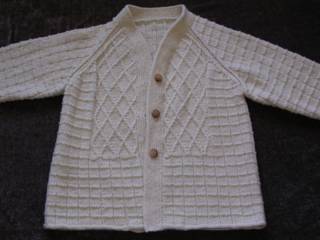
That's lattice stitch all over and diagonal window-pane stitch on the front panels.

Along the way, I made some changes to the AKJ pattern. The biggest change is the collar. The pattern called for a shawl collar, and I tried three times to make the collar curve gracefully around the V-neck. After a week of knitting and ripping, knitting and ripping, I gave up. There are just only so many times I'm willing to rip things out. So what you see is a simple garter button band, and it's good enough, damn it!
A few weeks back, I stopped by the fabulous Northwoods Mall here in Peoria. (It's worth noting that the woods are rather scant in this part of the Heartland.) Anyhoo, there at the Eddie Bauer store was a sweater rather remarkably like mine. Wearing the AKJ, I may for once be fashionable.
Wednesday, September 08, 2004
Thinking about Poetry
[Note: For some reason, this entry did not post on September 8 like I thought it did. Let's try again...]
Yesterday's rant about feeling down on a holiday seemed to do the trick. Once I hit the "post" button, I headed down stairs to tackle the garage. The garage is about as tidy as it will probably ever be. While we were cleaning, we found lots of things we'd lost of late, like the new pair of pruning shears, a set of garden gloves that fit my hands, and those old pair of flip flops I like to wear when we go swimming at the lake. Ah, a day well spent.
While I was mowing the lawn, Rolvaag's story about the old settlers in the Dakota's reminded me about a poem by Kevin Stein. Stein is Bradley professor, Poet Laureate for Illinois, and a local celebrity. He even has his own website. Something about Beret's story, a hard life made more difficult by fear, reminded me of one of the Stein poems I read in grad school. So I've dusted off my grad school books to find it. Here's a couple of stanzas from "St. Andrew's Catholic Men's Choir, after Practrice, at Blickwedel's Tavern and Grocery," one of the last poem in the collection Bruised Paradise.
Looking back, I overlooked that truth
like a lazy mushroom hunter too foolish
to paw beneath spring's wet leaves. I'd met
my wife at choir, her loveliness less of flesh
than the notion philosophers call essence,
what other men refuse to name for fear
they'll destroy, or understand, it--
either way it's gone, irretrievable
as first-ploughed prairie, its departure
attended by that ripping sound soil makes
as a blade cleaves its weave of big bluestems,
cornflower, chickory and more. Lord
knows, these women have little to show for it:
stooped backs, breasts that sag from their
intended use, a gold ring the only thing
that shines besides their blue-gray eyes,
bright with slant light sluiced through
glazed glass, children too young for lager
circled and shimmering at their feet.
The poem goes on, describing a typical immigrant's tale. The poem ends with the voice of the poem, an old farmer who's out drinking after church with his buddies, choked up at the thought of the life he's given his wife. So he asks god, "Why bless me?" It's a fitting tribute to the tough women who pushed plows through clay soil, drove oxen, sheared sheep, cooked dinner over buffalo chip fires, and lived in a sod house through long midwestern winters.
Tuesday, September 07, 2004
Thinking about Poetry
Yesterday's rant about feeling down on a holiday seemed to do the trick. Once I hit the "post" button, I headed down stairs to tackle the garage. The garage is about as tidy as it will probably ever be. While we were cleaning, we found lots of things we'd lost of late, like the new pair of pruning shears, a set of garden gloves that fit my hands, and those old pair of flip flops I like to wear when we go swimming at the lake. Ah, a day well spent.
While I was mowing the lawn, Rolvaag's story about the old settlers in the Dakotas reminded me about a poem by Kevin Stein. Stein is Bradley professor, Poet Laureate for Illinois, and a local celebrity. He even has his own website. Something about Beret's story, a hard life made more difficult by fear, reminded me of one of the Stein poems I read in grad school. So I've dusted off my grad school books to find it. Here's a couple of stanzas from "St. Andrew's Catholic Men's Choir, after Practice, at Blickwedel's Tavern and Grocery," one of the last poem in the collection Bruised Paradise.
Looking back, I overlooked that truth
like a lazy mushroom hunter too foolish to paw beneath spring's wet leaves. I'd met
my wife at choir, her loveliness less of flesh
than the notion philosophers call essence,
what other men refuse to name for fear
they'll destroy, or understand, it--
either way it's gone, irretrievable
as first-ploughed prairie, its departure
attended by that ripping sound soil makes
as a blade cleaves its weave of big bluestems,
cornflower, chickory and more. Lord knows,
these women have little to show for it:
stooped backs, breasts that sag from their
intended use, a gold ring the only thing
that shines besides their blue-gray eyes,
bright with slant light sluiced through
glazed glass, children too young for lager
circled and shimmering at their feet.
The poem goes on, describing a typical immigrant's tale. The poem ends with the voice of the poem, an old farmer who's out drinking after church with his buddies, choked up at the thought of the life he's given his wife. So he asks god, "Why bless me?" It's a fitting tribute to the tough women who pushed plows through clay soil, drove oxen, sheared sheep, cooked dinner over buffalo chip fires, and lived in a sod house through long midwestern winters.
Monday, September 06, 2004
It's Labor Day morning, the last day of a three-day weekend, and I've got the Vacation Blues. This happens whenever I look forward to a day off for weeks, and then when faced with the actual free-time on my hands, I start feeling down. Either I feel crabby because I'm not "taking advantage" of the time off by going jet skiing or climbing a cliff face, or I'm in the dumps because the short break from the every-day grind is almost over. This morning, I'm not sure which.
Last night I finished reading O.E Rolvaag's Giants in the Earth. I spent most of the weekend reading it, which brings about a common dilemma for me. Is reading a notable book a productive use of time, or it is complete laziness? Whenever I spend a weekend curled up with a book, I'm always fighting off "I should be cleaning out the basement" guilt. Maybe that's what made graduate school worth it. I had to read all those books because they were assigned.
Anyhoo, guilt or no, I managed to knock the book off in a couple of days, and it was an amazing read. I can't believe I'd never heard of this book before my sister Wendy recommended it. It's about a small group of Norwegian immigrants who are among the first settlers in the Dakotas after the Civil War. Rolvaag wrote the book in Norwegian, and then it was translated to English. It's full of references to Norwegian folktales--the settlers sense that "trolls" lurk just beyond the horizon--but it is a uniquely American tale. The romance of the West comes up short against the harsh reality of living in a sod house, outlasting Dakota winters, and fighting off grasshopper plagues. It seems the sort of book that high school 10th graders everywhere should read.
The book begins with the prairie protesting the arrival of the newcomers:
It bent resiliently under the trampling feet; it did not break, but it complained aloud every time--for nothing like this had ever happened to it before...'Tish-ah, tish-ah!' it cried, and rose up in surprise to look up at this rough, hard thing that had crushed it to the ground so rudely, and then moved on.
Beret, the mother in the story, becomes convinced the prairie is a living thing, a malevolent beast that is always watching, always waiting for its chance to strike.
Monsterlike the Plain lay there--sucking in her break one week, and the next week blew it out again. Man she scorned; his works she would not brook...She would know, when the time came, how to guard herself and her own against him!
Beret becomes more and more desolate, and eventually goes a bit looney. The other settlers realize that the prairie can do this to a person, they've seen it before and maybe felt a bit of it themselves. Eventually, Beret shakes off the insanity, and her delusions are replaced with a deep, unbending religious piousness. It is her unyielding beliefs that lead to the tragic end of the book (so perhaps this is why the book is not a school standard).
The book ending was so sad, and I dwelled on the tale all night. Could this be why I'm in a funk here on Labor Day? What's left of the prairie around Peoria must have turned its eye on me...
Thursday, September 02, 2004
Yesterday's entry got me thinking about cookbooks. The recipe comes from the 1986 edition of Betty Crocker's Cookbook. From what I can remember, the pictures, the recipes, and the thorough but rather bland cooking advice is the same from the 1972 edition we used as kids. Looking through it now, it seems old-fashioned. Instead of telling you how to cook a dinner in 30 minutes with five ingredients or less, this cookbook is like a museum of American cooking, before the age of Lean Cuisine and the microwave oven. Want to know how to cook beets? Betty gives you several healthy and delicious suggestions. Unsure how to roast a side of pork? Step-by-step directions are available on page 220.
The cookbook I remember from my childhood was from the era when Betty wore a stylin' beehive hairdo. With her stern gaze and from that determined set of her mouth, she looked like the ultimate mother. The Ladies Auxiliary president. The best authority on how to make a cake rise or ways to thicken a gravy without lumps. When I found out Betty was not a real woman, that there wasn't a Mother Superior dispensing wisdom from the cleanest kitchen in the world, I was shocked. She has a whole cookbook named after her. How can she not be real? (This wasn't quite as devastating as learning there was no Santa, but it ranks up there on the "This is a Cruel, Cruel World" realization list.)
These days, I love the pictures of Betty Crocker through the ages. (You can check them out here.) I think the 1950's Betty looks like Eleanor Roosevelt. The 1986 Betty looks like she's entered the World of Work. With bow tie at her throat, I'd say she's an attorney who balances raising her kids, running five miles a day, volunteering at the local homeless shelter, and serving as the president of the PTA.
In the 1990s, I remember when they introduced the newest Betty Crocker image. The produce of computer morphing, the new Betty was younger and had darker hair and skin tones--a more multicultural Betty. Funny, I've looked all around the Betty Crocker web page, and I don't see her picture anywhere.
Wednesday, September 01, 2004
There has been a request that I share the Hot Fudge Sundae Cake recipe. Now that the last of this dessert has gone to a better place (namely my stomach), I'll relive the chocolate goodness by sharing the recipe with you.
Hot Fudge Sundae Cake
The first part is easy. It's basically like making a batch of brownies.
1 cup flour
2/3 cup granulated sugar
2 T cocoa
2 t baking powder
1/4 t salt
2 T vegetable oil
1 t vanilla
1 C nuts (or chocolate chips)
Heat the oven at 350. Mix flour, granular sugar, 2 T cocoa, baking powder, and salt. Add milk, oil, vanilla, and nuts. Spread in a 9x9x2 pan.
So far, so good. The next part is the "hot fudge sundae" part of the cake. It may seem crazy, but it works. Have FAITH.
1 C packed brown sugar
1/4 C cocoa
1 3/4 C Hottest tap water
Sprinkle the brownie mixture with the brown sugar and 1/4 C cocoa. Pour hot water over the batter. Bake for 40 minutes. Serve warm, topped with ice cream.
Pouring water on top of a perfectly good cake mixture seems weird, and I know because I've been there. Once you pour the water on top, the cake will look disgusting and you'll feel like you've ruined everything. But don't despair! Pop the pan in the oven, and all will be well!

